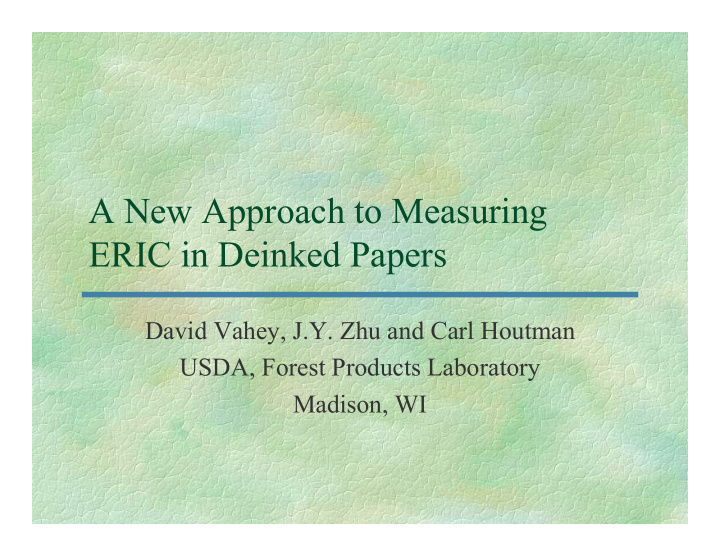



A New Approach to Measuring ERIC in Deinked Papers David Vahey, J.Y. Zhu and Carl Houtman USDA, Forest Products Laboratory Madison, WI
Effective Residual Ink Conc. (ERIC) 950 nm Ink Assumption: At Absorbance 950 nm any absorbance is Paper (x100) due to ink 200 400 600 800 1000 1200 Wavelength (nm)
ERIC Uses Near Infrared (950 nm) to Emphasize Ink Absorbers Ink Dye Lignin = Visible Light = Near Infrared (NIR) NIR Absorption depends mostly on ink concentration
ERIC Measurement Reflectance at 950 nm using d/0º R o R ∞ Stack of Single sheet similar over a black sheets cavity
Advantages of ERIC Measurement • Rapid, commercially available • Suitable precision for control actions • An improvement over brightness measurement – More sensitive to ink – Less sensitive to dyes and lignin
Disadvantages of ERIC Measurement • When R o and R ∞ are close, the errors increase • Some samples exhibit such low reproducibility that results become meaningless • Sample must be repositioned to take the two measurements
Goals of the Study • Explore the sources of inconsistency in ERIC measurements • Determine the impact of using a different wavelength and/or geometry (e.g. 750 nm with a UV/Vis spectrophotometer) • Develop a preliminary error analysis
Light-Paper Interaction Theory I = 100%, Incident Illumination R = % Reflection A* A = % Absorption T = % Transmission Conservation of Energy → 100% = R + T + A
Approximate ERIC calculation ⎛ ⎞ − − 1 R T ⎜ ⎟ ≈ × ERIC (ppm) 100 ⎜ ⎟ 2 ( ) ⎝ ⎠ w kg m w = Basis Weight R = Reflectance fraction T = Transmittance fraction
Standard ERIC Measurement Approach R 0 R ∞ Single A* Sheet T>0 Thick Stack T = 0
Kubelka-Munk Theory I J In differential form: dI = -(K+S) I dx + S J dx dJ = -S I dx + (K+S) J dx x Gain Loss from of scattering J I
a bit of mathematics….
Standard ERIC calculations ( ) Problem: 2 − 1 R = × ∞ 100 ERIC →∞ ERIC S 2 R as R o /R ∞ → 1 ∞ ⎡ ⎤ ⎡ ⎤ − 1 R R R = ∞ ∞ ( ) 0 ln ⎢ ⎥ ⎢ ⎥ S − 2 − 1 1 ⎣ ⎦ R R ⎣ ⎦ w R ∞ 0 ∞ w = basis weight, in kg/m 2
ERIC Measurement Problem with Opaque Papers R 0 R ∞ Single A* ~R 0 T 2 Sheet * R 0 /R ∞ ≈ 1-R 0 T 2 T ≈ 0 ~R 0 T Thick Stack
High Opacity Paper • With opacity > 97%, R o and R ∞ are very close, thus the estimate of S is very poor. • One possible solution is to use an estimated value for S avg (near 50 m 2 /kg for TMP). • Another is to base ERIC on R and T measurements instead of R o and R ∞ .
The R and T Method for ERIC I = 1, Incident Illumination R = Reflection * T = Transmission − − ( 1 ) 2 2 ⎡ 1 ⎤ R T = − + − − 100 x sinh 1 ( 1 2 2 ) 2 4 2 ERIC T R R ⎢ ⎥ ⋅ − + − ⎣ ⎦ ( 1 2 2 ) 2 4 2 2 w T R R T
Experimental Setup for ERIC by the R and T method Chopper Aperture Aperture Paper Lamp Lens R T Moveable Detector for Amplifier Transmission (T) and Reflection (R) Oscilloscope
Experimental Samples • TMP: 65 g/m 2 handsheets from pulp samples with varying degrees of residual ink. • Kraft: 65 g/m 2 handsheets from pulp samples with residual ink from laser printing. • Newsprint: 50 g/m 2 page from a directory.
Summary of Results Sample Opacity ERIC, by method RT R 0 R ∞ S avg R ∞ Commercial News 81.7 181 127 140 Kraft 83.2 189 149 158 TMP 1 94.6 519 417 504 602 TMP 2 96.1 702 558 693 792 TMP 3 98.7 1106 939 1100 1238
ERIC Results by Three Different Methods 1400 100 o 1120 80 Opacity ERIC (ppm) Opacity (%) ERIC 840 60 o RT R o R o o o o o sR o o o 560 40 sR :Technidyne oo 280 20 0 0 News Kraft Trial 1 Trial 2 Trial 3 Sample
Typical ERIC values • ERIC ≈ 1000 ppm, for newsprint at the start of deinking • ERIC ≈ 200-300 ppm for commercial recycled newsprint
ERIC Error Analysis 100 RT R 0 R sR S oo oo 70 50 40 Data ERIC COV (%) 40 20 10 6 0 200 400 600 800 1000 1200 ERIC (ppm)
Conclusions • ERIC values greater than 800 ppm are prone to errors with standard R o R ∞ method. • Use of an estimated scattering coefficient S make comparisons between different papers difficult. • ERIC measurement using R and T – Requires no assumptions about S. – Becomes increasingly accurate at high ERIC
Recommend
More recommend